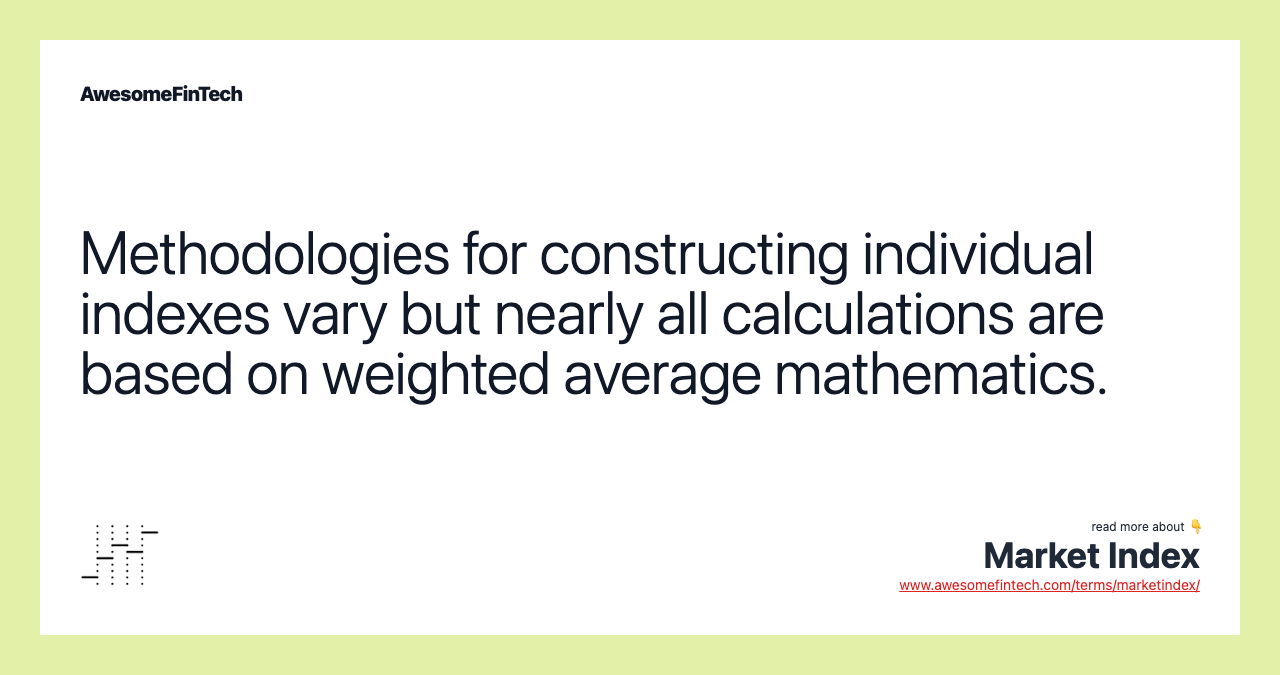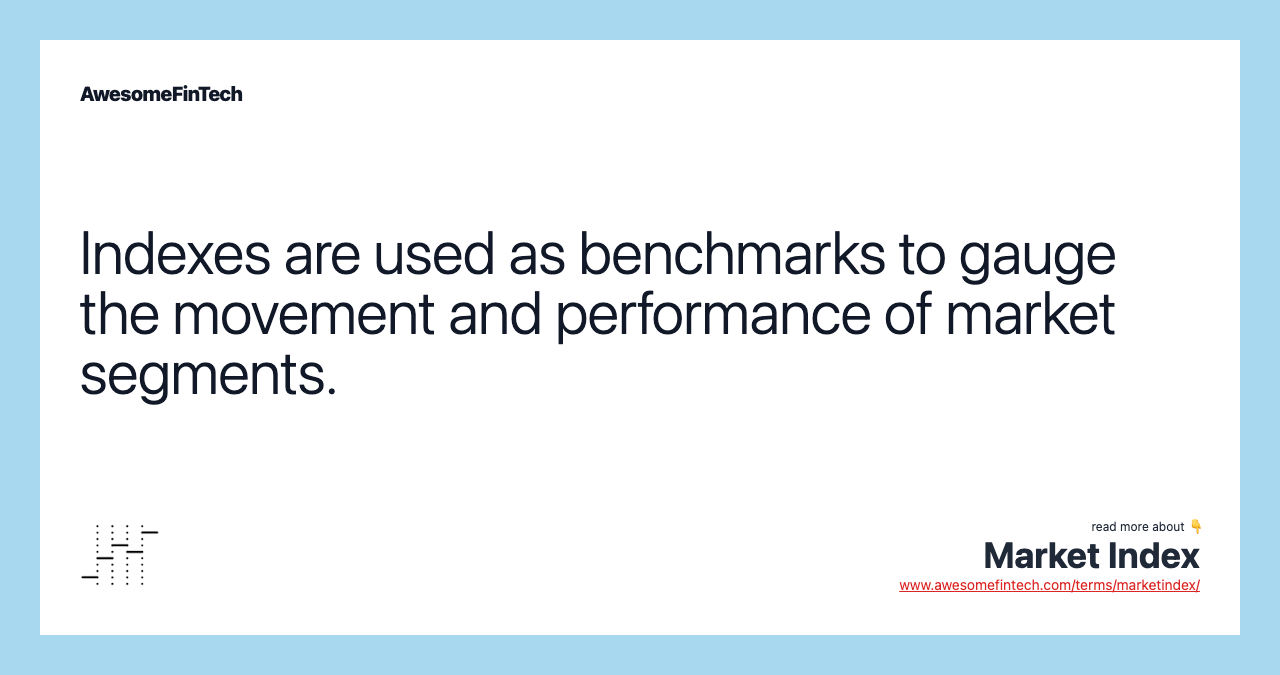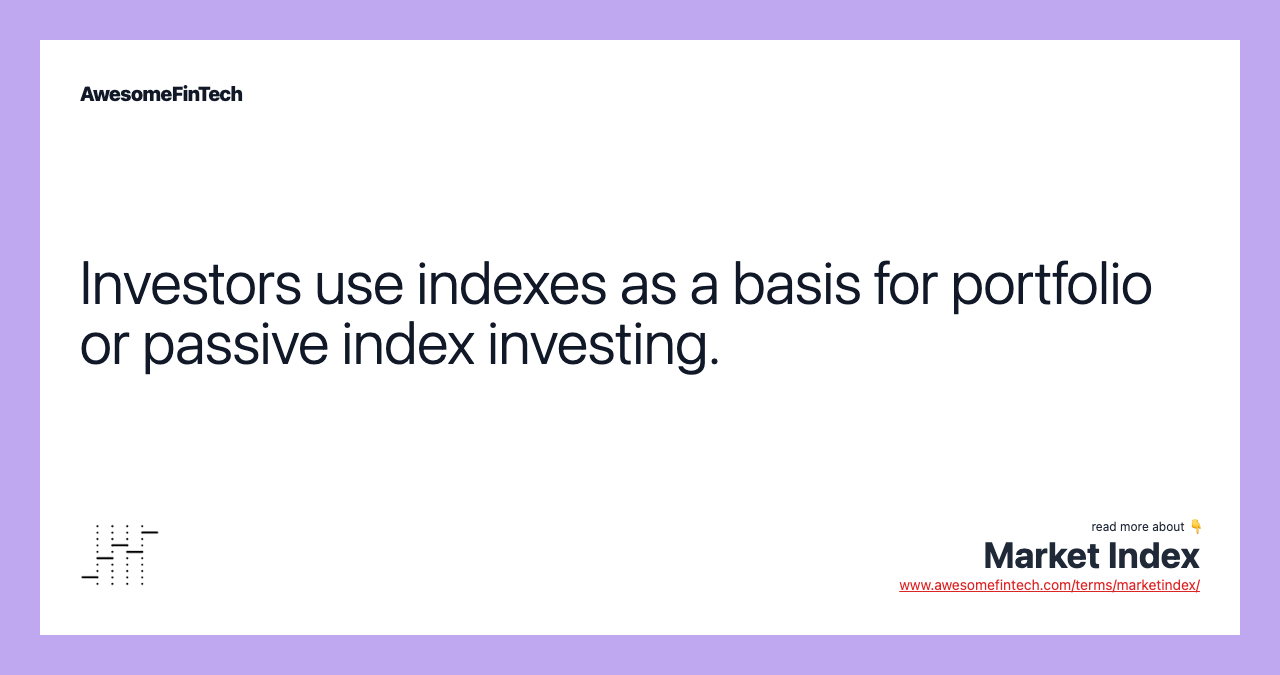Market Index
A market index is a hypothetical portfolio of investment holdings that represents a segment of the financial market. Some of the market’s leading indexes include: Dow Jones Industrial Average Nasdaq Composite Russell 1000 S&P MidCap 400 Russell Midcap Russell 2000 U.S. Aggregate Bond Market Global Aggregate Bond Market Investors often choose to use index investing over individual stock holdings in a diversified portfolio. In the bond market, Bloomberg Barclays is a leading provider of market indexes with the Bloomberg Barclays U.S. Aggregate Bond Index serving as one of the most popular proxies for U.S. bonds. Investors cannot invest directly in an index, so these portfolios are used broadly as benchmarks or for developing index funds. Some popular emerging growth indexes and corresponding exchange traded funds (ETFs) include the following: The iShares Global Clean Energy ETF (ICLN), which tracks the S&P Global Clean Energy Index The Reality Shares Nasdaq NexGen Economy ETF (BLCN), which tracks the Reality Shares Nasdaq Blockchain Economy Index The First Trust Nasdaq Artificial Intelligence and Robotics ETF (ROBT), which tracks the Nasdaq CTA Artificial Intelligence and Robotics Index The three most popular stock indexes for tracking the performance of the U.S. market are the Dow Jones Industrial Average (DJIA), S&P 500 Index and Nasdaq Composite Index.

What Is a Market Index?
A market index is a hypothetical portfolio of investment holdings that represents a segment of the financial market. The calculation of the index value comes from the prices of the underlying holdings. Some indexes have values based on market-cap weighting, revenue-weighting, float-weighting, and fundamental-weighting. Weighting is a method of adjusting the individual impact of items in an index.
Investors follow different market indexes to gauge market movements. The three most popular stock indexes for tracking the performance of the U.S. market are the Dow Jones Industrial Average (DJIA), S&P 500 Index and Nasdaq Composite Index. In the bond market, Bloomberg Barclays is a leading provider of market indexes with the Bloomberg Barclays U.S. Aggregate Bond Index serving as one of the most popular proxies for U.S. bonds. Investors cannot invest directly in an index, so these portfolios are used broadly as benchmarks or for developing index funds.




Understanding a Market Index
A market index measures the value of a portfolio of holdings with specific market characteristics. Each index has its own methodology which is calculated and maintained by the index provider. Index methodologies will typically be weighted by either price or market cap. A wide variety of investors use market indexes for following the financial markets and managing their investment portfolios. Indexes are deeply entrenched in the investment management business with funds using them as benchmarks for performance comparisons and managers using them as the basis for creating investable index funds.
Market Index Methodologies
Each individual index has its own method for calculating the index’s value. Weighted average mathematics is primarily the basis for index calculations as values are derived from a weighted average calculation of the value of the total portfolio. As such, price-weighted indexes will be more greatly impacted by changes in holdings with the highest price, while market capitalization-weighted indexes will be most greatly impacted by changes in the largest stocks, and so on, depending on the weighting characteristics.
Market Indexes as Benchmarks
As a hypothetical portfolio of holdings, indexes act as benchmark comparisons for a variety of purposes across the financial markets. As mentioned, the Dow Jones, S&P 500 and Nasdaq Composite are three popular U.S. indexes. These three indexes include the 30 largest stocks in the U.S. by market cap, the 500 largest stocks, and all of the stocks on the Nasdaq exchange, respectively. Since they include some of the most significant U.S. stocks, these benchmarks can be a good representation of the overall U.S. stock market.
Other indexes have more specific characteristics that create a more narrowly targeted market focus. For example, indexes can represent micro-sectors or maturity in the case of fixed income. Indexes can also be created to represent a geographic segment of the market such as those that track the emerging markets or stocks in the United Kingdom and Europe. The FTSE 100 is an example of such an index.
Investors may choose to build a portfolio with diversified exposure to several indexes or individual holdings from a variety of indexes. They may also use benchmark values and performance to follow investments by segment. Some investors will allocate their investment portfolios based on the returns or expected returns of certain segments. Further, a specific index may act as a benchmark for a portfolio or a mutual fund.
Index Funds
Institutional fund managers use benchmarks as a proxy for a fund’s individual performance. Each fund has a benchmark discussed in its prospectus and provided in its performance reporting, thus offering transparency to investors. Fund benchmarks can also be used to evaluate the compensation and performance of fund managers.
The year the Dow Jones Railroad Average, a precursor to the Dow Jones industrial Average, was published by Charles Dow. The average was composed of nine railway companies, a steamship company and Western Union.
Institutional fund managers also use indexes as a basis for creating index funds. Individual investors cannot invest in an index without buying each of the individual holdings, which is generally too expensive from a trading perspective. Therefore, index funds are offered as a low-cost way for investors to invest in a comprehensive index portfolio, gaining exposure to a specific market segment of their choosing. Index funds use an index replication strategy that buys and holds all of the constituents in an index. Some management and trading costs are still included in the fund’s expense ratio, but the costs are much lower than fees for an actively managed fund.
Real World Examples
Some of the market’s leading indexes include:
Investors often choose to use index investing over individual stock holdings in a diversified portfolio. Investing in a portfolio of indexes can be a good way to optimize returns while balancing risk. For example, investors seeking to build a balanced portfolio of U.S. stocks and bonds could choose to invest 50% of their funds in an S&P 500 ETF and 50% in a U.S. Aggregate Bond Index ETF.
Investors may also choose to use market index funds to invest in emerging growth sectors. Some popular emerging growth indexes and corresponding exchange traded funds (ETFs) include the following:
Related terms:
Benchmark
A benchmark is a standard against which the performance of a security, mutual fund or investment manager can be measured. read more
Bogey
Bogey is a buzzword that refers to a benchmark used to evaluate a fund's performance and risk characteristics. read more
Capitalization-Weighted Index
A capitalization-weighted index is a type of market index with individual components that are weighted according to their total market capitalization. read more
Constituent
A constituent is a single stock or company that is part of a larger index such as the S&P 500 or Dow Jones Industrial Average. read more
Diversification
Diversification is an investment strategy based on the premise that a portfolio with different asset types will perform better than one with few. read more
Dow Jones Industrial Average (DJIA)
The Dow Jones Industrial Average (DJIA) is a popular stock market index that tracks 30 U.S. blue-chip stocks. read more
Exchange Traded Fund (ETF) and Overview
An exchange traded fund (ETF) is a basket of securities that tracks an underlying index. ETFs can contain investments such as stocks and bonds. read more
The of Expense Ratio
The expense ratio (ER), also sometimes known as the management expense ratio (MER), measures how much of a fund's assets are used for administrative and other operating expenses. read more
Financial Markets
Financial markets refer broadly to any marketplace where the trading of securities occurs, including the stock market and bond markets, among others. read more
Fixed Income & Examples
Fixed income refers to assets and securities that bear fixed cash flows for investors, such as fixed rate interest or dividends. read more